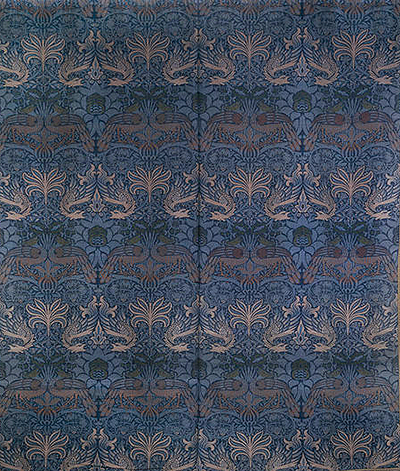Morris' Peacock and Dragon was initially intended to be used for curtains or wall coverings. The content and style of this piece is believed to have been inspired by some exotic influences, moving away from the artist's traditional British roots.
The designer was known to have loved this piece, and would even install it within his own home at Kelmscott House in Hammersmith. A pair of curtains from 1878 which carry the Peacock and Dragon design can be found in the permanent collection of the V&A Museum in London, UK, as part of their fine survey of his career. This would be another popular design with the public who was delighted to bring this style into their own homes, although they were instructed that it was only really suited to larger rooms, because of the nature of the design. It may have been because of the large and detailed nature of this design that it may have been unsuitable for smaller rooms, and perhaps Morris was working to combine elements of foreign design with British methods in how the final piece would be delivered. The tones used for this piece are actually more subtle and not as bright as some of his other designs, presenting a different finish that might suit slightly alternative tastes.
Within the set of curtains, you will find two dragons with their heads facing each other in the lower section, with peacocks placed just above. Between them is a series of floral patterns typical of Morris, and in the curtains found at the V&A, it is the dragons that are slightly clearer and bolder, because of the lighter tones used for them. This popular design would then be used in many other notable properties, besides just Morris' own home, underlining its importance and popularity. The curtains themselves were manufactured back in 1878 and were made from wool, with the artist choosing this material in order to replicate some of the medieval tapestries that he would have studied earlier in his life. He continually sought to acquire new artistic skills and had a natural ability to learn techniques remarkably quickly. The nature of his business meant that he would need to be adaptable to customer's tastes and requests and would not always be able to bring in specialists to deliver new products.
Peacock and Dragon remains one of the artist's most famous designs and continues to re-appear today in all manner of different guises. Several manufacturers offer examples from his career in a mixture of product types such as curtains, wallpaper, prints and more. His popularity is just as strong today as ever, and Morris' desire for a return to traditional values and methods seems just as appropriate in the present day as it ever has been. He remains one of the most famous British artists of all time and he is particularly well served within the V&A Museum in London, as well as a number of other smaller collections around the country. This was a key period in British art, as we approached the turn of the century.




